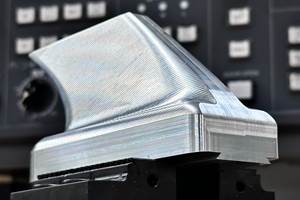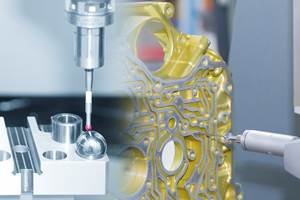The Effect of Lot Size on Productivity
The more parts to be produced, the more elaborate the manufacturing process. Here are some other important considerations that can impact productivity.
Share






Understanding factors that contribute to your company’s identity, and addressing those that are most important to your company, will dramatically improve its CNC machine utilization. In past months, I have discussed company type, repeat business and lead time. This month, I am focusing on lot size, which I define as the number of workpieces produced during a single production run.
Almost every process-related decision you make should begin with a simple question: “How many parts are we making?” The more parts to be produced, the more elaborate your processes can be. There will, however, be challenges throughout the entire lot-size spectrum. For this discussion, I define lot sizes as:
- Extremely small (1-3 parts)
- Small (3-20 parts)
- Medium (21-100 parts)
- Large (100-1,000 parts)
- Extremely large (more than 1,000 parts)
Process Considerations
With smaller lot sizes and assuming program execution time is relatively short, no special consideration need be given to workholding or cutting tool selection. Just about any process that makes an acceptable workpiece will work. But as lot sizes grow, so does the need to reduce program-execution time while maintaining quality specifications. Any additional costs incurred because of a more elaborate process will be justified by the reduced time needed to complete the production run. With extremely large lot sizes, you should be able to justify anything it takes to get the last second out of the machining cycle.
Programming Considerations
With extremely small through small lot sizes, and especially when combined with short cycle times and few repeated jobs, offline programmers will not be able to keep up with production needs. If programming time is not internal to production run time, you should consider shopfloor-programmed (conversational) CNCs and having your CNC operators create programs during setup.
Engineering Considerations
The engineering I am thinking of here is related to making things easier for the setup person and operator: documentation and the like. The goal is to minimize mistakes and save time. With smaller lot sizes, and especially with limited repeat business, it may be difficult to justify much engineering past developing a machining process and creating rudimentary setup instructions. With minimal engineering, of course, the operator running the job must be highly skilled. (An exception is if you know the job will be repeated multiple times in the future, since the engineering time and effort can be justified over the part’s life.)
As lot sizes grow, it is likely that more than one person will be involved with the production run (tool-crib attendants; setup people; first, second and third shifts; inspectors; and so on). In these cases, there is a much greater need for task-simplifying engineering. Additional documents could include more elaborate setup instructions that list components and their locations, process drawings that specify machining operations to be performed and control sheets that describe measurements to be taken along with the offsets needing adjustment. In addition to documentation, task-simplifying engineering can include any studies and actions that improve the way a job is run.
Setup and Cycle-Time Reduction Considerations
I define setup time as the period from running the last part in the previous production run to running the first (good) workpiece in the next production run. Cycle time (per part) is the total time it takes to run the rest of the parts divided by how many parts have been run.
Given similar program execution times, machines will be in setup for a greater percentage of production run time when running smaller lots. With very small lot sizes, for instance, it is not uncommon for setup time to far exceed the time required to run out the job. When trying to improve machine utilization given this scenario, you should first concentrate on setup time.
As lot sizes grow, the percentage of time a machine is in setup will shrink. With large and very large lots, setup may be but a small part of the production run. In these cases, it would be better to target cycle time for improvement. While you should concentrate on things that happen during every cycle, like program execution time, part load/unload, cleaning/deburring and so on, don’t forget about things that do not, like tool maintenance, sampling inspections and machine warmup.
Personnel Utilization Considerations
The larger the average lot size, the more tasks that can be performed offline in preparation for upcoming jobs. As lot sizes grow, there comes what I call a break-even point when there is ample time for someone (probably not the setup person or operator) to do all of legwork needed for upcoming jobs. Setup-related tasks could include acquiring related documentation, gathering components and measuring devices, assembling cutting tools, and taking certain cutting tool measurements. Production-run tasks could include gathering resources to complete the run, like inserts, raw material and coolant. This will minimize the amount of work a setup person or operator must do while the machine is down.
Related Content
Custom Workholding Principles to Live By
Workholding solutions can take on infinite forms and all would be correct to some degree. Follow these tips to help optimize custom workholding solutions.
Read MoreHow to Evaluate Measurement Uncertainty
Manufacturing and measurement are closely coupled. An important consideration for the use of measurement results is the associated measurement uncertainty. This article describes common metrology terms and provides an example uncertainty analysis.
Read MoreRethink Quality Control to Increase Productivity, Decrease Scrap
Verifying parts is essential to documenting quality, and there are a few best practices that can make the quality control process more efficient.
Read More4 Manufacturing Trends That Cannot Be Ignored
The next five years will present their own unique set of challenges, and shops can alleviate them by embracing these technologies and trends.
Read MoreRead Next
AMRs Are Moving Into Manufacturing: 4 Considerations for Implementation
AMRs can provide a flexible, easy-to-use automation platform so long as manufacturers choose a suitable task and prepare their facilities.
Read MoreMachine Shop MBA
Making Chips and 91ÊÓƵÍøÕ¾ÎÛ are teaming up for a new podcast series called Machine Shop MBA—designed to help manufacturers measure their success against the industry’s best. Through the lens of the Top Shops benchmarking program, the series explores the KPIs that set high-performing shops apart, from machine utilization and first-pass yield to employee engagement and revenue per employee.
Read MoreLast Chance! 2025 Top Shops Benchmarking Survey Still Open Through April 30
Don’t miss out! 91ÊÓƵÍøÕ¾ÎÛ's Top Shops Benchmarking Survey is still open — but not for long. This is your last chance to a receive free, customized benchmarking report that includes actionable feedback across several shopfloor and business metrics.
Read More.jpg;width=70;height=70;mode=crop)






















